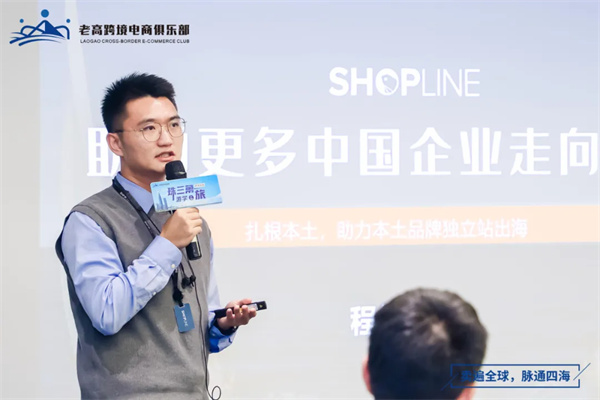From October 18 to 21, the Laogao Cross-border E-commerce Club held a study tour, spanning three cities: Shenzhen, Zhuhai and Guangzhou. During the study tour, we interviewed two senior people in the field of cross-border e-commerce, one was Cheng Chuanchi, head of the Guangzhou team of Shopline, and the other was Ye Zhicong, general manager of overseas e-commerce of Miniso (Miniso) . Let’s talk about cross-border e-commerce together, hoping to give some reference to domestic sellers who are preparing to plan cross-border e-commerce.
What is the easiest pitfall for domestic e-commerce to cross-border transformation?
Cheng Chuanchi, head of the Guangzhou team at Shopline, reported a common phenomenon from the perspective of an independent website, that is, when domestic sellers transformed, they lacked their understanding of overseas users . Merchants did not know what overseas consumers demanded for products and what their functions were. Most of them did not understand the audience, users, regions, and the range of consumer demand.
Cheng Chuanchi believes that this problem is also easy to solve, which is to return to market research and product selection research. The domestic first-tier retail platforms such as Tmall, JD.com, and Taobao have made very good products, and the response when entering the foreign retail market is difficult to determine. Because there are many successful domestic brands or products, the response is not ideal when entering new markets.

Therefore, if you are sure to enter cross-border e-commerce, you must improve the product functions or change the copywriting and marketing methods. This is the first pit that you should avoid on the product side.
The second is to set a target that is not suitable in the early stage. Most people may first select 2-3 products, and then let go and promote it around a larger sales target. This actually lacks certain market testing actions. From the perspective of entrepreneurs, it should be done in the form of the minimum trial and error cost of MVP.
Independent sites can actually carry this part of the demand. They can screen out competitive products through certain market research, enter the targeted market and audience, conduct batch testing, thereby obtaining the market verification of the product and then expanding the volume.
Recommendations for domestic sellers who are preparing to do cross-border e-commerce?
Cheng Chuanchi thinks that first of all, we need to look at our products and supply chains, and whether we can support several common models in independent websites, because whether cross-border e-commerce is fast launching new products or a large number of test models, this requires the supply chain to have very strong response speed and ability.
Secondly, if you have a strong understanding of overseas user surveys or product surveys, it is recommended to be a small and beautiful brand, and to target a narrow enough market and audience, you can also make a relatively high brand premium. Judging from the entire capital market now, this model is favored.

Cross-border e-commerce is a business with a long chain. Even if a seller with a certain size in China wants to re-enter the cross-border e-commerce business, it will not be easy or even difficult to adapt. Therefore, Shopline is also gathering service providers or resource providers with advantages in the entire ecosystem, such as technology, traffic, marketing, and international logistics, to help Chinese sellers go overseas.
Because the chain of cross-border e-commerce is relatively long and is very close to the domestic supply chain and consumer path, but it is a bit different, Cheng Chuanchi suggests that we must fully consider the long cycle of cross-border e-commerce and the timeliness of local products, do a good job in market research, build a good platform, and then make efforts.
Ye Zhicong, general manager of Miniso overseas e-commerce, also agreed with this suggestion. He also thinks that the easiest way is to conduct research first, targeting cross-border e-commerce platforms, including overseas social media, to investigate whether their categories are suitable for local consumers and to understand how big the local market is, so that the advantages of domestic e-commerce can be leveraged.

What is the impact of the epidemic on the cross-border e-commerce industry?
Cheng Chuanchi said that the epidemic has a relatively large impact on the industry, and technology will basically not regress. When consumers' consumption habits are formed, it is not easy to be reversed. In the past two years of the outbreak of the epidemic, overseas retail has been online in advance because foreign consumers have already tended to be online and are forced to be faster by the epidemic.
Chinese sellers should observe the next cross-border e-commerce track, and which models are more suitable for today's Chinese sellers. The use of independent stations in overseas consumers accounts for an increasingly heavy proportion. In the future, cross-border e-commerce will be a platform and independent stations that will work side by side , each of which will shoulder the goals that should be shouldered and achieve sales growth, exposure, and brand building.

Ye Zhicong felt that the most obvious impact of the epidemic was also the change in consumer demand. In addition, he also saw changes in the entire logistics link, including price and timeliness, which had great changes.
Therefore, he also suggested that Chinese sellers should prepare in advance and not make overly radical investments, because there are many abnormal situations in cross-border e-commerce, and the category may suddenly explode, but it may also change due to the recovery of the epidemic, so they should make better plans and make not particularly radical preparations.
What is the future trend of cross-border e-commerce?
Cheng Chuanchi believes that cross-border e-commerce is definitely worthy of layout, because the overseas market is extremely large, while the domestic market has already seen a white-hot intra-conversion, and it is relatively serious. However , overseas markets, whether it is market size, consumer scale, or room for consumption power upgrading, have a large enough market, which is worth Chinese sellers' exploration . China's supply chain can play a great enough benefit in cross-border e-commerce.
A truly great company or a company that can grow must have strategic thinking and will always lay out some tracks in advance. When the opportunity comes, you can get enough profits and returns at that time.
In Ye Zhicong's eyes, there are two major dividends for cross-border e-commerce. One is the advantage of China's supply chain, because 70%-80% of the global categories are produced and manufactured in China, so the advantages of the supply chain must be utilized. The second is the development of China's entire e-commerce business, including the development of talents, models, and product technology, which is very mature, and will inevitably lead the world . With the support of China's advantages, now is the best time to go overseas.










 EN
EN CN
CN
